Artificial Light Balance for growing different varieties of tomatoes in different environments
Rez Mani1*, Ian Godfrey2
1Allied Scientific Pro, 815 Blvd de la Carriere Office 203, Gatineau, QC, J8Y 6T4, Canada
2University of South Florida, Tampa, Florida, USA
Corresponding author: rmani@alliedscientificpro.com, Tel: +1-800-253-4107
Abstract: Three different varieties of tomatoes which were F1 Trust (indeterminate variety large round red tomato) Gold Rave (golf ball size orange plum tomato), and Indigo cherry drop (Black cherry tomato) were grown in three different environments with different sources of light. The first environment was a LED chamber with no access to sunlight, the second, was a greenhouse with supplementary artificial lighting and the third was the outside garden.
The LED units that were used in the LED chamber were Solar system 275 and 550 from California Light Works. They were capable of being programmed and hence adjustment of intensity at different wavelengths was possible. A proper light balance between different required wavelengths at each stage of growth is a key to a healthy and productive growth of a plant. The LED units primarily contained 450 nm blue and 660 nm red radiation. Each stage of growth from seedling to final tomato production had its own recipe. The times of day were also divided into sunrise, late morning, mid-afternoon, late afternoon and sunset and each period was assigned its own light intensity. The lighting passport handheld spectroradiometer from Asensetek was used to make measurements of the PPFD in μmol/m2/sec for each wavelength in the range of 380-780 nm. For Far red measurements from another supplementary far red lamp provided by California Light Works, a different spectroradiometer called SRI2000 with a spectral range of 250-850 nm was used.
The quality and morphology of the tomatoes grown in different environments were compared and conclusions were drawn about the usefulness of each wavelength of artificial light for growth of tomatoes. In the past, different varieties of tomato have always been grown using sunlight as the light source for their photosynthesis. The sun which is a 5800° blackbody, produces a continuous range of wavelengths but not all of these wavelengths are equally needed for the growth of a vegetable. The light intensity, wavelength and photo-period are all important parameters that need to be considered.
INTRODUCTION
With the recent population growth and shortage of necessary agricultural land to feed the growing population, attention has been turned to artificial lighting such as LEDs to grow tomatoes and other vegetables indoors1. Technological advancement in LED design has enabled a range of wavelengths from UV to Far-Red to be produced and several LED fixtures have the capability to adjust the intensity of individual wavelengths and therefore different light recipes suitable for different stages of the growth of a vegetable can be produced. This way, one can select or enhance the intensity of the important wavelengths and reduce or eliminate the intensity of the other less important wavelengths. This will optimize the usage of Photosynthetically Active Radiation (PAR). For the purposes of photosynthesis and photomorphogenesis of a plant, light balance has a crucial importance. Each wavelength serves a purpose2 and throughout the different stages of growth of a plant, wavelength intensities need to be adjusted to suite the need of a plant. These wavelength usages for the particular case of tomatoes are listed in table 1.
Color | Approximate wavelength (nm) | Usage for tomatoes |
Blue | 450 |
|
Green | 520 |
|
Red | 660 |
|
Far red | 730 |
|
Table 1: Principle wavelengths required for the growth of tomatoes and their effect
In table 1, there has been no mention of UV wavelengths since the LED modules that were used could not produce any UV radiation. For far red radiation which is outside the PAR range, the conversion of active form (PFr) to inactive form (Pr) by exposure to Far-red radiation is very important for flowering and stretching of the stem.
VARIETIES OF TOMATOES, DIFFERENT ENVIRONMENTS AND EQUIPMENT
The three varieties of tomatoes (produced from Johnny’s seeds) used for this research have been shown in figure 1.
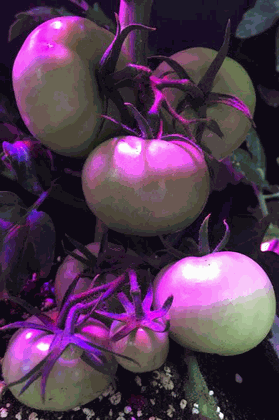
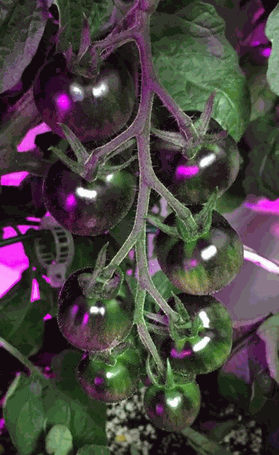
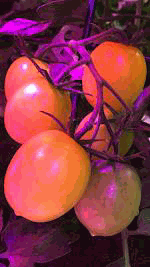
Figure 1: Varieties of tomato from left to right, F1 Trust, Indigo Cherry and Gold Rave
These varieties of tomato were grown in three different environments in Tampa Florida which has a warm climate and in general hot and humid summers. The three environments namely the LED chamber with LED artificial light, the greenhouse with supplementary artificial light and the outside garden are shown in figure 2.
The LED modules were solar system 275 and 550 units from California light works which produced plenty of blue and red and a residual amount of green. The lighting passport by Asensetek which is a spectroradiometer with a range of 380-780 nm was used to measure the PPFD spectrum for each environment.
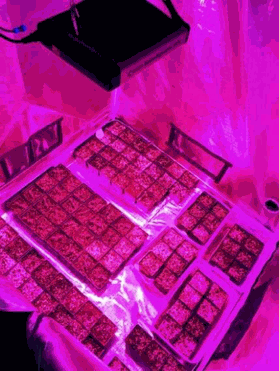
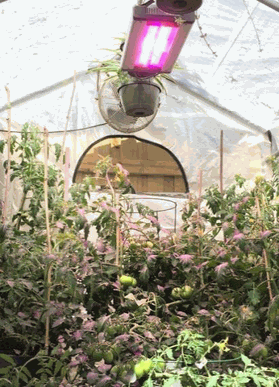
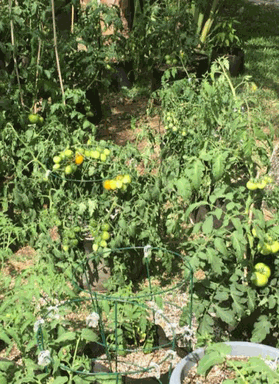
Figure 2: From left to right, LED chamber, greenhouse with supplementary light and outside garden
Aside from the LED unit with lighting controls, the LED chamber shown in the left picture of figure 2 is equipped with air conditioning and operates at 76°F (summer temperature in Florida are in the 80° range). It is also equipped with carbon dioxide supply, monitoring equipment, hydroponic irrigation system and air sanitation. The greenhouse also contains the same LED unit, but it is only on for a few hours in the morning and in the evening (2 three hour periods). The greenhouse runs on sunlight as the source of the light for most of the day. A fan, observed on the top part of the middle picture in figure 2 stirs the air, produces a breeze and cools the greenhouse. The outside garden is watered regularly on an everyday basis but experiences high temperatures and humidity during the summer. A spectrum of the LED source at full strength measured by the lighting passport is shown in figure 3. The light source and the plant information can be stored in the Spectrum Genius app used with the lighting passport along with the spectrum.


Figure 3: The PPFD spectrum of the LED module was measured by the lighting passport and was the source of illuminance in the LED chamber and the greenhouse. The black curve is the McCREEs action spectrum.
During the early and late hours of the day that the LED is on inside the greenhouse, the resulting PPFD is a superposition of the LED spectrum and the sun’s blackbody curve. The spectrum was measured by a SRI2000 spectroradiometer (250-850 nm range) and the Lighting Passport (380-780nm range) as shown in figure 4A and left of 4B. Figure 4B, also shows the spectrum of the sun for the outside garden area on the right side.

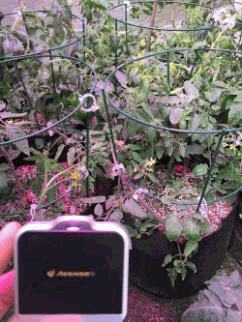
Figure 4 A: Combined spectra of the LED module and sun in the greenhouse. Middle right is SRI2000 module and far right is the lighting passport.


LIGHT RECIPES
Five different spectral recipes were used throughout the day that corresponded to sunrise, late morning, high or mid-afternoon, late afternoon and sunset were measured using the lighting passport. The purpose was to simulate the variation in the sun’s spectral power distribution (SPD) throughout the day3. The R/B changes throughout the day and the five pre-programmed SPDs in the LED units tried to simulate these variations. Figure 5 shows the five spectra.

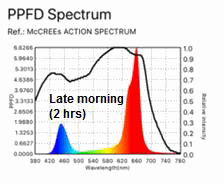
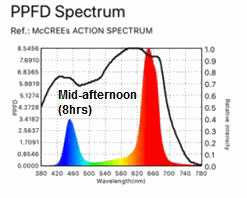
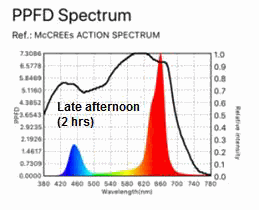
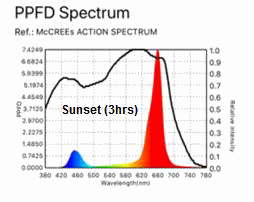
Figure 5: Variation of LED intensity (SS550) throughout an 18 hour day. The black colored curve is the McCree reference spectrum. All measurements were done by the lighting passport.
Also there were different light recipes corresponding to different stages of growth which can be classified as the seedling, early vegetative, late vegetative, early fruit, and late fruit. Each stage has its own recipe. For the seedling and vegetative stages a less intense LED unit (SS275 from California Light works with 200 Watt electrical draw) was used but for the fruiting stages the LED source was switched back to SS550 (400 Watt electrical draw). Figure 6 shows the late morning and midafternoon recipes for each stage of the tomato growth as measured by the lighting passport.

Figure 6: Late morning and mid-afternoon recipes for different stages of tomato growth & the Solar System controller which was used for programing on the far right.
Another wavelength of importance is far red radiation at 735 nm which is usually used for the End Of the Day (EOD) treatment for about 15-30 minutes. The ratio of Red to far red naturally decreases during the twilight and this EOD has the positive effect of stem elongation. Far red stimulates phytochrome Pfr4 and studies have found that exposing seedling to far red increases the mesocotyl biomass5, which is the tubular white stem like tissue connecting the seed and the base of the coleoptile. A far red lamp from California Light Works was used in addition for EOD treatment. Figure 7 shows the Solar System far-red fixture and its corresponding far-red spectrum as measured by the lighting passport.

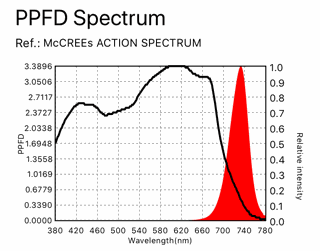
Figure 7: Far red supplementary lamp for EOD treatment
GROWTH RESULTS:
Growing the three different varieties of tomato in the three different environments had various requirements and has produced different results. The photo-period for the LED chambers were 18 hours (5am-11pm) with the LED lighting intensity varying in 5 different stages as shown in figure 5. For the greenhouse and outside garden, the photoperiod was 12 hours corresponding to daylight in spring with the difference that the greenhouse has its supplementary LED light on in two 3 hour periods during the day light (8-11 am and 5-8 pm). Therefore the LED chambers had 6 extra hours of illumination per day (Received more quality blue and red). The LED chamber also benefited from air conditioning which regulated the temperature at 76° F, CO2 supply, air sanitation and a hydroponic system. Increased levels of CO2 combined with high PPFD levels of blue 450 nm wavelength, and low temperatures helped to drive a rapid rate of photosynthesis and thus created an optimum growth environment for rare tomatoes. Table 2 shows average temperatures, average CO2 levels in parts per million, and corresponding photoperiod for each of the three cultivation areas.
Table 2: Average temperatures, CO2 levels, and photoperiod for each cultivation area
The plants showed similar morphology in the greenhouse and outside area, however plants in the LED chamber showed noticeable differences in leaf, flower and fruit morphology. Plants in the LED chamber produced more flowers with a higher fruit development success rate. The vines correspondingly developed to have a larger radius with much more strength which was required to hold up the numerous fruits that developed. This held true for all three tomato varieties grown in the LED chamber.
The outside garden was in Tampa, Florida where the temperatures get really hot in summer up to the mid 80°s. There was the requirement to water the plants everyday outside whereas in the LED chamber and the greenhouse, the water requirement was every three days. The greenhouse had a fan (figure 2) to produce a breeze inside and balance the temperature. The oscillation fan was a critical component of the greenhouse as it contributed to the cooling of the leaves surface temperature, influencing the opening of stomata and increased photosynthesis. The temperatures would get really hot in mid-day in Florida in the greenhouse and especially in the outside garden. This caused drooping of leaves, temporary weakening of stems and increased water requirements. Table3, figure 8, figure 9 and table 4 compare number of flowers in flower clusters for three typical vines in each environment and the average fruit production percentages for flower clusters of each vine.
1st vine | 2nd vine | 3rd vine | % Flowers-Fruit | |
LED Chamber | 9,11,14 | 9,14,16 | 14,15,16 | 100 |
Greenhouse | 5,7,8 | 4,8,8 | 5,9,11 | 75 |
Outside Garden | 1,5,6 | 3,5,7 | 4,5,8 | 65 |
Table 3: Indigo Cherry number of the first three flower clusters on the three vines per cultivation area and the corresponding percentage of flowers that developed into fruit.
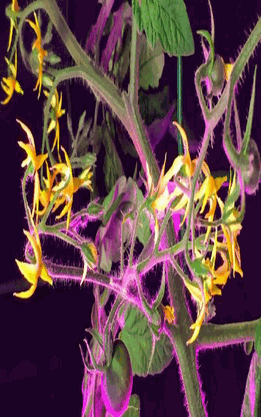
 Figure 8: Flower count on the Indigo Cherry Drop vines were greatest out of all three cultivar in all three environments.
Figure 8: Flower count on the Indigo Cherry Drop vines were greatest out of all three cultivar in all three environments.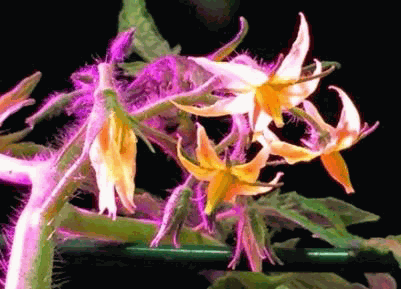

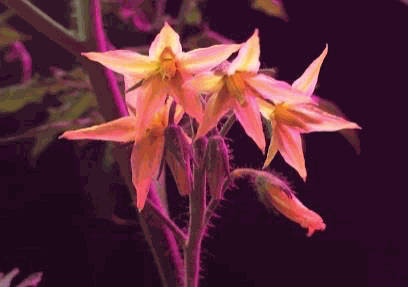
Figure 9: Flower clusters on F1 Trust, Indigo Cherry Drops, and Gold Rave from left to right. Pictures are taken in the LED chamber.
| F1 Trust | Gold Rave |
LED Chamber | 95% | 100% |
Greenhouse | 85% | 80% |
Outside Garden | 75% | 75% |
As far as the three varieties of tomato are concerned, the indigo cherry drops were the most difficult to cultivate outside due to excess heat but did well in the greenhouse and LED chamber. The other two varieties, F1 Trust and Gold rave did well in all three environments. F1 Trust was the only variety that was grown in the outside garden previously to this study by one of the authors of this article and had done relatively well. Figure 10 shows significant drooping of the Indigo Cherry Drop variety outside and less in the greenhouse and the LED chamber.
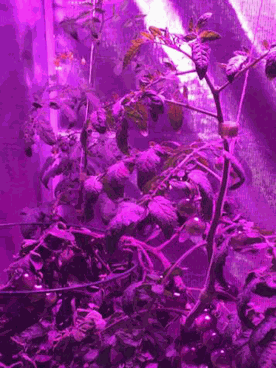
LED Chamber

Greenhouse
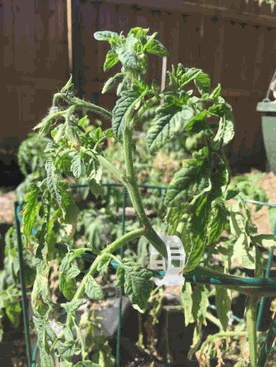
Outside Garden
Figure 10: From left to right, Indigo Cherry Drop plants in the LED Chamber, Greenhouse, and Outside Garden. Significant drooping is observed in the outside garden due to the mid-day light intensity and heat
F1 trust variety also shows some drooping in the outside garden as compared to greenhouse and LED chamber. In addition, F1 variety produces more leaves in similar vine heights in the LED chamber as compared to outside garden as shown in figure 11.
Figure 10: From left to right, Indigo Cherry Drop plants in the LED Chamber, Greenhouse, and Outside Garden. Significant drooping is observed in the outside garden due to the mid-day light intensity and heat
F1 trust variety also shows some drooping in the outside garden as compared to greenhouse and LED chamber. In addition, F1 variety produces more leaves in similar vine heights in the LED chamber as compared to outside garden as shown in figure 11.

F1 LED chamber

F1 Greenhouse
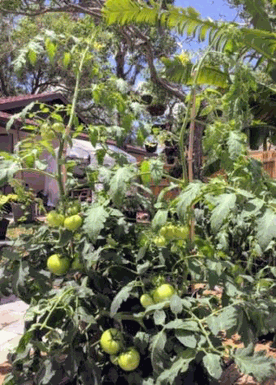
F1 Trust outside
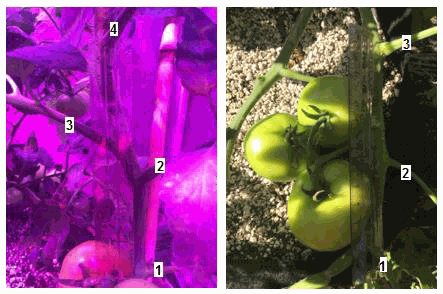
F1 LED chamber 4 leaves/5 inches & F1 outside 3 leaves/5 inches
Figure 11: F1 trust variety also shows some drooping in the outside garden. The two pictures below show a more compact vine as compared to outside garden.
The average internodal distance in inches for each variety was different at each stage for each environment and they are listed in table 5.
LED Chamber | F1 Trust | Gold Rave | Indigo Cherry Drop |
Vegetative Stage | 1.3” | 1.5” | 1.3” |
Flower Stage | 1.4” | 1.5” | 1.9” |
Greenhouse with LED | F1 Trust | Gold Rave | Indigo Cherry Drop |
Vegetative Stage | 1.5” | 1.6” | 1.8” |
Flower Stage | 2” | 2” | 2.2” |
Outside Garden | F1 Trust | Gold Rave | Indigo Cherry Drop |
Vegetative Stage | 2” | 1.6” | 2” |
Flower Stage | 2.4” | 2.2” | 2.2” |
Table 5: Average internodal distance in inches for all three varieties in the three different environments
The compactness of LED grown variety is visible from the data. This compactness can be associated with increased level of blue light in the LED chamber which inhibits stretching6.
Understanding artificial light balance will help cultivators influence desired characteristics like more compact tomato vines with larger amounts of fruit per flower cluster. Figure 12 compares trichome clusters of the Gold rave leaves grown in the LED chamber and the greenhouse.

Figure 12: Shows Gold Rave leaves that were trimmed off the vine along with the first fruit clusters. Left side shows trichome development from LED chamber and the right is from the greenhouse.
Differences in morphology of leaves were observed and noted. Leaves from all plant varieties in the LED chamber were smaller than those of the plants in the greenhouse and outside garden because they received more blue light (which is absorbed by cryptochromes and phototropins6) and less green light which inhibits stretching6. There was little to no differences in leaf size when the greenhouse plants were compared to those plants outside. Also the leaves that developed in the LED chamber showed a significant amount of stomata underneath the leaf. The plants in the greenhouse and outside garden did not have this large number of stomata underneath the leaves like the LED chamber plants did. In fact the stomata were everywhere on the bottom side of the leaf surfaces on the LED chamber plants. The leaves from LED chamber and the green house had wider stomata as compared to the outside garden for which the stomata were frequently closed due to hot temperatures on the leaf surfaces and increased green light levels which counteracts blue light action to open the stomata6. Figure 13 shows the abundance and opening of stomata in LED chamber and compares it with the greenhouse and outside garden.

Figure13: Showcases the stomata on the Indigo Cherry Drops in all three environments; LED chamber, greenhouse, and outside garden respectively. Notice how the images coming from the LED chamber and greenhouse have large, clear, open stomata, compared to the outside garden where the stomata are frequently closed due to hot temperatures on the leaf surfaces and also increased green light levels.
Finally, there was a difference in leaf color and fruit color between the varieties grown in the LED chamber and the ones in outside garden. The color of the leaves and fruits in the LED chamber was darker as compared to the outside garden as shown in figure 14. 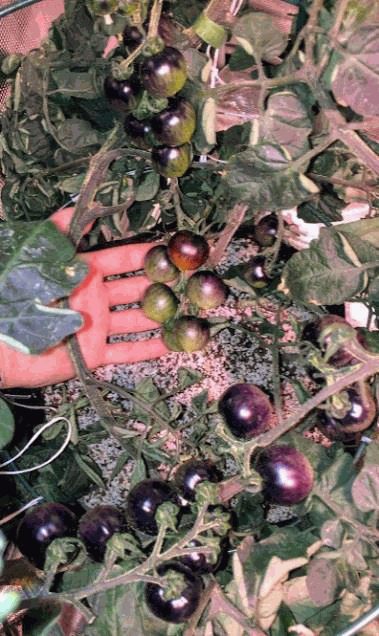

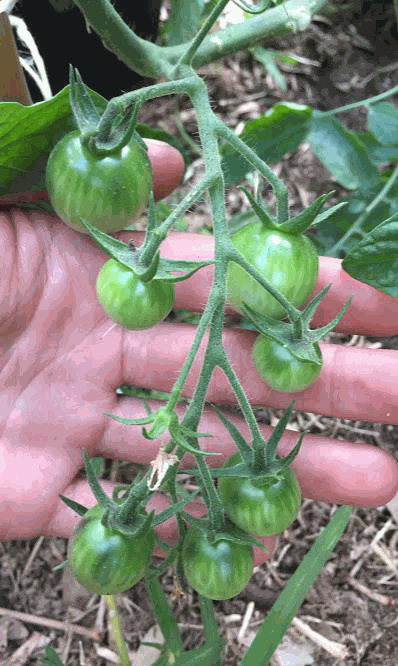
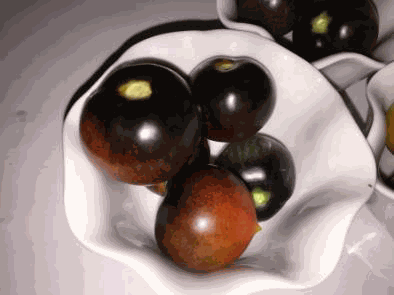
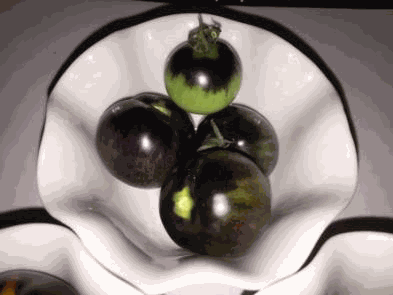

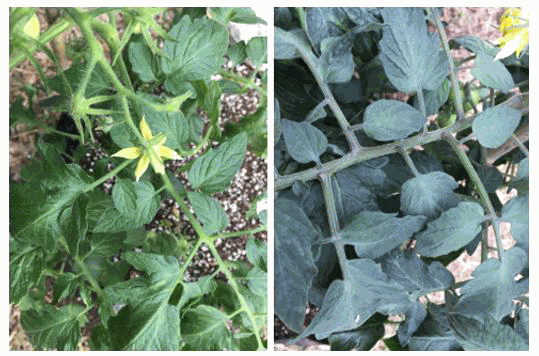
Figure 14: From left to right is the true color of Indigo Cherry Drops still on the vine top & just harvested bottom from the LED chamber, greenhouse, and outside garden area respectively. Also the darker leaf color for the LED chamber is at the bottom left when just moved outside.
The darker colors of the fruits and the leaves could be correlated to the increase amount of blue light which is known to affect pigmentation through the action of cryptochrome recepetors6.
For the Indigo Cherry Drops fruit size was slightly larger and the color was much richer as produced from the plants in the LED chamber as seen in figure 15.

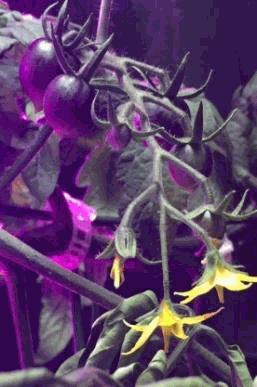
Figure 14: Indigo Cherry Drops showed the most variation in color between the three cultivation environments. Much of the fruit in the LED chamber were completely black
Figures 15A and 15B compare the colors of indigo cherry drops and gold rave harvested in the three environments.
 Figure 15A: From left to right True Color of Indigo Cherry Drops in the LED chamber, greenhouse, and outside garden area. The fruits from the LED chamber were slightly larger and had a much richer color tone
Figure 15A: From left to right True Color of Indigo Cherry Drops in the LED chamber, greenhouse, and outside garden area. The fruits from the LED chamber were slightly larger and had a much richer color tone

Figure 15B: From left to right. True Color of Gold Rave in the LED chamber, greenhouse, and outside garden area. The fruits from the LED chamber were slightly larger but there was not much color difference observed in this cultivar
In general, the yield, richness of color, fruit size and the quality of the tomatoes grown in the LED chamber were better as compared to the greenhouse and the outside garden. These rare varieties of tomatoes are not normally grown in the hot and humid environment of Florida except for F1 trust as mentioned previously.
CONCLUSION
Rare tomato varieties do better in controlled environment LED chambers. The optimum cultivation environment was closest to being achieved in the LED chamber through the combination of controlled environment agriculture equipment and an understanding of artificial light balance. We associate the compactness of the plant, darker color of leaves/fruits and increased opening of the stomata to increased blue levels and reduced green levels in the LED chamber. The Far-red EOD treatment helped with increased levels of flowering and yield. Increased photo-period (18 hours) and shining quality red and blue light on the tomato plants coupled with other control factors (temperature control, increased CO2 level, etc.) also increased the LED chamber tomato yield as compared to the other two environments. This project proved that rare varieties of tomato can be cultivated in LED chambers in geographical areas where the environment is generally not suitable for their growth due to high temperatures and humidity levels. Cultivators that grasp the concept of artificial light balance will be able to use LED fixtures to influence desired plant characteristics and fruit morphology while propelling their crops toward their genetic maximum potential. The lighting passport and SRI2000 spectro-radiometers were important tools to make sure the PPFD levels are correct throughout the day and also during different stages of growth.
ACKNOWLEDGEMENTS
We would like to thank Allied Scientific Pro for providing the lighting passport and the SRI2000 spectro-radiometers for the measurements of light intensity and spectra and California Light Works for providing the LED fixtures. We would also like to thank Johnny’s Selected Seeds and their team for their breeding, trials, and genetic selection expertise. Microbelife hydroponics, Age Old Organics, and Pennsylvania Perlite Corporation were also essential to the overall success of the cultivation project. The first author would like to acknowledge that all the growth work and measurements were done by the second author, in his hometown of Tampa, Florida.
REFERENCES
Cary A Mitchell, Academic research perspective for the horticulture industry, Hortscience, Sept 2015, Vol 50, no 9, 1293-1296.
Toyoki Kozai, Genhua Niu, Michiko Takagaki, Plant factory, 1st edition, an indoor vertical farming system for efficient quality food production, paper back ISBN: 9780128017753, 2015.
Joseph Bass and Joseph S. Takahashi, Circadian integration of metabolism and energetics, Science. 2010 Dec 3; 330(6009): 1349–1354.
Keara A. Franklin and Garry C. Whitelam, Phytochrome and shade avoidance responses in plants, Ann Bot. 2005 Aug; 96(2): 169–175.
Patrice G. Dubois, Gregory T. Olsefski, Sherry Flint Garcia, Tim L. Setter, Owen Hoekenga and Thomas P. Brutenell, Physiological and genetic characterization of end of day far red light response in Maize seedlings, Plant Physiol. 2010 Sep; 154(1): 173–186.
Kevin Folta and Sofia D. Carvalho, HortScience Vol.50(9), September 2015.
1Allied Scientific Pro, 815 Blvd de la Carriere Office 203, Gatineau, QC, J8Y 6T4, Canada
2University of South Florida, Tampa, Florida, USA
Corresponding author: rmani@alliedscientificpro.com, Tel: +1-800-253-4107